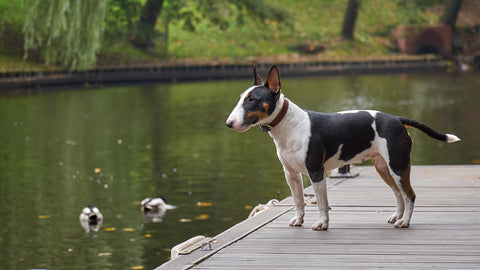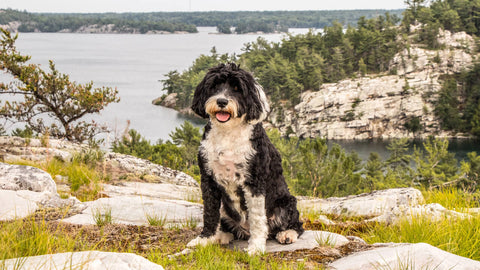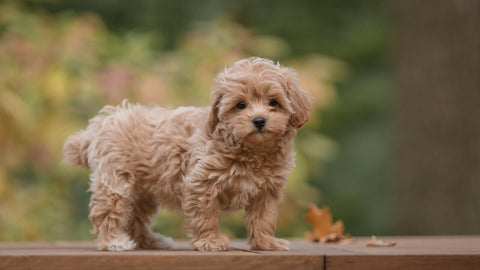Contents:
- Introduction to the Bull Terrier
- Appearance of the Bull Terrier
- Coat and colours of the Bull Terrier
- How big can a Bull Terrier get
- The character of the Bull Terrier
- Training the Bull Terrier
- For whom is the Bull Terrier suitable
- Is the Bull Terrier a family dog
- Care of the Bull Terrier
- Nutrition of the Bull Terrier
- How much does a Bull Terrier shed
- How old does a Bull Terrier get
- Typical diseases of the Bull Terrier
- How much does a Bull Terrier puppy cost
- What to look out for when buying a Bull Terrier
- Bull Terrier profile
Introduction to the Bull Terrier
The Bull Terrier is a unique dog breed with a strong character, which stands out above all for its unmistakable appearance and strong build. Known for their egg-shaped head and lively eyes, Bull Terriers are particularly energetic and loyal companions Originally bred in England in the 19th century as a fighting dog to combine strength and agility, the Bull Terrier has now become a popular family dog and companion, valued for its friendly and brave character.
Appearance of the Bull Terrier
The Bull Terrier is instantly recognisable by its distinctive head, which is egg-shaped and flat. The eyes are small, almond-shaped and set low in the face, giving the dog an intelligent, alert expression. The ears are small, pointed and erect. The Bull Terrier's body is muscular, compact and well-proportioned. The chest is broad, the back short, and the limbs are strong These dogs have an athletic build that makes them very agile and mobile.
Coat and colours of the Bull Terrier
The Bull Terrier has a short, shiny coat that lies close to the body. It feels smooth and fine, which makes it relatively easy to care for The Bull Terrier comes in a wide range of colours. The most common colours are pure white, but brindle, black, red, fawn or tri-coloured (black and white with brown markings) are also found. White Bull Terriers often have spots in a different colour on their head or ears, which gives their appearance an additional individual character.
How big can a Bull Terrier get?
Bull Terriers come in two sizes: the standard Bull Terrier and the miniature Bull Terrier. A fully grown standard Bull Terrier can reach a height of between 45 and 55 cm and usually weighs between 22 and 38 kg. The miniature Bull Terrier is smaller and reaches a shoulder height of about 35 cm and a weight of 11 to 15 kg.
The Bull Terrier's character
The Bull Terrier is known for its brave, spirited and sometimes stubborn character. These dogs are incredibly loyal and strongly attached to their owners. They are usually very playful, have a strong will and high energy Despite their history as fighting dogs, today's Bull Terriers are friendly and people-oriented dogs that like to be the centre of attention. They are curious, intelligent and love to explore their surroundings. At the same time, however, they can also be stubborn and assertive, which is why a consistent approach to training is important.
Training a Bull Terrier
Training a Bull Terrier requires patience, consistency and clear leadership. Since these dogs can be stubborn, it is important to show them boundaries early on and to have a firm but loving hand. Positive reinforcement, such as praise and treats, often works best. Early socialisation is especially important to get the Bull Terrier used to other animals and people The breed can tend to be dominant, so it's important to control the dog well and channel its energies in the right direction.
Who is the Bull Terrier suitable for?
The Bull Terrier is not suitable for everyone. Due to its strong character and high energy, it needs an owner who is experienced with dogs and able to train it consistently. It is ideal for active people or families who have a lot of time and patience to train and keep the dog occupied. People who like to do sports or go on long walks will find a great companion in a Bull Terrier.
Is the Bull Terrier a good family dog?Yes, the Bull Terrier can be an excellent family dog. It is particularly loyal and affectionate towards its family members, especially children. However, children should learn how to treat dogs respectfully, as Bull Terriers can sometimes be a little boisterous. Since these dogs like to get a lot of attention, they enjoy being part of family life and being included in activities Despite their playfulness, they should always be supervised when interacting with smaller children.
Grooming the Bull Terrier
Grooming a Bull Terrier is relatively straightforward, as their short coat requires little maintenance. Regular brushing – about once or twice a week – is enough to keep their fur shiny and healthy and remove loose hairs Since Bull Terriers can be prone to skin problems, their skin should be checked regularly and special shampoos used if necessary. Their ears should be kept clean and their nails short. Regular dental hygiene should also be ensured.
Nutrition of the Bull Terrier
The Bull Terrier's diet should consist of high-quality dog food that provides all the necessary nutrients A balanced diet with sufficient protein and fat is important to support the muscular body of the dog. Bull Terriers tend to be overweight, which is why it is important to control the amount of food precisely and not to give too many treats. Fresh water should always be available, and for special health requirements, a nutritional consultation with a veterinarian can be helpful.
How much do Bull Terriers shed?Bull Terriers shed a moderate amount of hair. Their short fur loses hairs throughout the year, although the hair loss can be more intense in spring and autumn. Regular brushing helps to minimise hair loss and keep the fur clean and shiny.
What is the average life expectancy of a Bull Terrier?
A healthy Bull Terrier can expect to live for about 10 to 14 years on average. Good care, a balanced diet and regular visits to the vet will help to ensure that your dog enjoys a long and healthy life.
Typical diseases of Bull Terriers
Bull Terriers are generally robust dogs, but they are prone to certain health problems. The most common of these include skin problems, such as allergies or skin inflammation, as well as kidney problems (especially hereditary nephritis) Heart problems and deafness also occasionally occur, especially in pure white Bull Terriers. Regular veterinary monitoring and early diagnosis can help to identify and treat many of these problems.
How much does a Bull Terrier puppy cost?
The cost of a Bull Terrier puppy can vary greatly depending on the breeder, origin and pedigree. Prices are usually between CHF 1200.00 and CHF 2500.00. It is particularly important that the puppy comes from a reputable breeder who values health and species-appropriate rearing.
What should you watch out for when buying a Bull Terrier?
When buying a Bull Terrier puppy, it is important to choose a reputable breeder who raises their dogs with love and expertise. Make sure that the breeder has tested the parent animals for genetic diseases, in particular for kidney problems and deafness The puppy should be healthy and well socialised, and the breeding environment should be clean and well maintained. A reputable breeder will always be keen to meet the new owners and ensure that the dog is going to a suitable home.
Bull Terrier profile
Height: 45–55 cm (standard), up to 35 cm (miniature)Weight: 22–38 kg (standard), 11–15 kg (miniature)
Life expectancy: 10–14 years
Coat: Short, smooth, shiny
Colours: white, brindle, black, red, tri-coloured
Character: brave, loyal, playful, stubborn
Suitable for: active families, experienced dog owners
Origin: England
Grooming: low




Comments (0)
There are no comments for this article. Be the first one to leave a message!